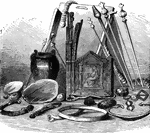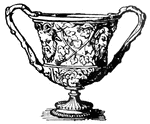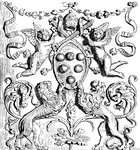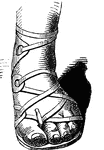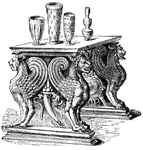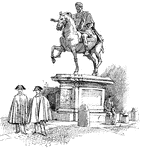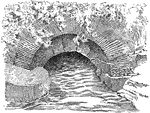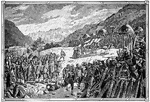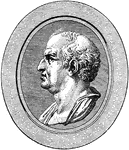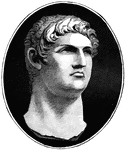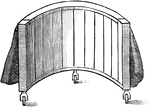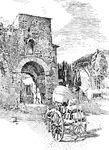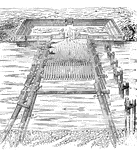This ClipArt gallery offers 396 images of the Roman Empire including culture, people, everyday life, coats of arms, and more. See also the Roman Coins, Roman Architecture, Roman Ornament, Roman Mythology, and Ancient Roman Musical Instruments ClipArt galleries.
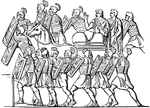
Hollow Square
Military formation of the Romans, also agmen quadratum. Square formation with no troops in the middle.
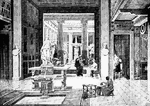
House
"A Roman house. In early times the private houses of the Romans were very simple, showing little attempt…
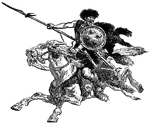
Hun Warrior on Horseback in Battle
Illustration of a Hun warrior riding on horseback, his mouth open as if to scream. The warrior has a…
!["[Caesar] mustered the soldiers in the Campius Martius, and requested a statement of their grievances. Their demands appeared to have a reference to a payment of their dues, the bestowal of promised presents, and a release from further duty. Caesar well knew that the best way to humiliate an insurrection is to grant what it clamors for. He accordingly made an address to his old legion, being careful to begin with "Citizens," instead of "Soldiers." This was gall and wormwood. To be addressed as citizens by their beloved commander! "I discharge you." said he. "You have had enough of fatigue and wounds. I release you from your oath. As to your presents, you shall be paid to the last sesterce." The old veterans could stand no more. They burst into tears, and began to beg for forgiveness. With a certain prudent hesitation, Caesar received them back to favor; but he took care that the leaders who had fomented the mutiny should be executed."—Ridpath, 1885](https://etc.usf.edu/clipart/78900/78945/78945_citizens_01_mth.gif)
Citizens! I Discharge You.
"[Caesar] mustered the soldiers in the Campius Martius, and requested a statement of their grievances.…
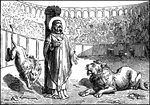
Ignatius of Antioch is Martyred by Being Fed to Lions
Illustration of Ignatius of Antioch, also called Ignatius Theophorus, tied to a post by his neck and…
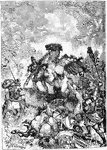
Death of Julian the Apostate
A depiction of Julian the Apostate, a noted philosopher and Roman Emperor, and his death.

A Roman Litter
"The litter consists of an ordinary couch with four posts and a pair of posts. Curtains fastened to…
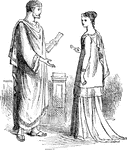
Man and Woman in Roman Clothing
An illustration of a man and woman standing in typical Roman clothing. Clothing in ancient Rome generally…
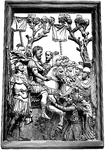
Marcus Aurelius and German Captives
"Marcus Aurelius receiving the submission of German captives. (From a Bas-relief in the Capitoline Museum,…

Medal of Abila
A medal of Abila, representing the head of Faustina, wife of emperor Marcus Aurelius on one side. The…

Medal of Geba
A medal engraved with the portrait of Empress Plautina, her name inscribed on one side. The other side…

Medal of Sardis
One side of the medal is engraved with the portrait of Proserpine, who was worshiped in Sardis. The…

A Monk with a Pointed Hood and Crosses on His Habit
Illustration of a monk, displaying an open book. His hood is pointed and appears to be unattached from…
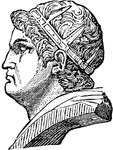
Nero
Roman emperor, son of Sneius Domitius Ahenobarbus and Agrippina, daughter of Germanicus, born at Antium,…
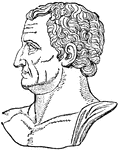
Nerva
"Nerva, the successor of Domitian, and one of the most virtuous of the Roman emperors. He was born in…
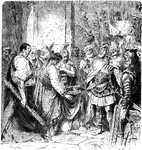
Odoacer Compels Augustulus to Yield the Crown
Augustulus is deposed from the crown by Odoacer, and was thus the last Western Roman Emperor.

Paenula
"A thick cloak, cheifly used by the Romans in traveling, instead of the toga, as a protection against…

Pala
"The spade was but little used in ancient husbandry, the ground having been broken and turned over by…

Pallium
"An outer garment. The English cloak, though commonly adopted as the translation of these terms, conveys…

Paludamentum
"The cloak worn by a Roman general commanding an army, his principal officers and personal attendants,…
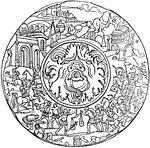
Parma
"A round shield, three feet in diameter, carried by the celites in the Roman army. Though small, compared…
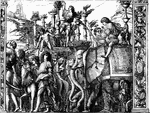
Part of the Triumphs of Julius Cesar
This painting is by Andrea Mantegna is a good example of how the artist placed the figures in the background.…

Pistor
"A baker, from pinsere, to pound, since corn was pounded in mortars before the invention of mills. At…
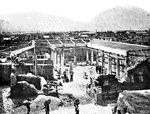
Pompeii
"Excavating a house at Pompeii from eruption of Vesuvius, which buried the cities of Herculaneum and…

Pompeii Graffiti from the House of Dioscuri - Gladiator Holding Palm Leaf
A drawing of one section of the graffiti found on the house of Dioscuri in Pompeii. A gladiator descends…
Pompeiian Stand with Lighted Oil Lamp
A tall, thin lamp stand on a round, ornamented base with three claw feet. The top of the stand has a…
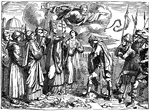
Pope Leo the Great Approaches Attila, King of the Huns, on the Battlefield
Illustration of Pope Leo, dressed in full papal costume and holding the primatial cross, approaches…
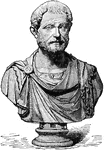
Probus
"The next Emperor was Aurelius Probus, officer of the army of Germany. He was chosen by the legions,…
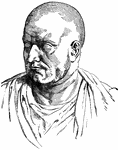
Publius Cornelius Scipio Africanus
Publius Cornelius Scipio Africanus was a general in the Second Punic War and statesman of the Roman…
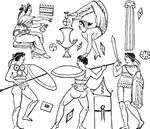
Pyrrhic Dance
"The most famous of all the war-dances of antiquity, is said to have received its name from one Pyrrichos,…

A Roman Aqueduct
"The Pont du Gard near Nimes (ancient Nemausus) in southern France. Built by the emperor Antoninus Pius.…


